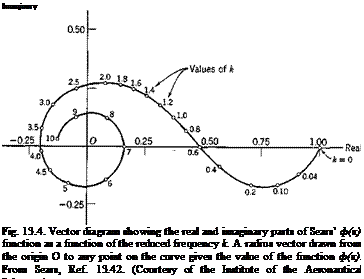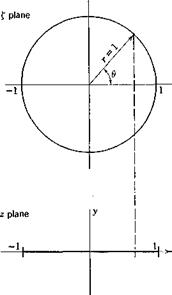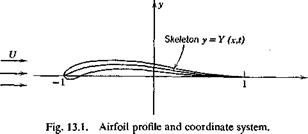Let us consider first the vertical-translation oscillations. Using the complex representation of harmonic oscillations, we may describe the airfoil surface by the equation
У = Уфеш (1)
where y0 is a real number representing the ratio of the amplitude of the vertical motion to the semichord b of the airfoil which is taken as 1 in the following analysis. y0 is therefore dimensionless. It is convenient for the following derivation to express the circular frequency m in terms of the nondimensional reduced frequency k. Using the semichord b — 1 as the characteristic length, we define
, cob ft)
Hence, Eq. 1 may be written as
У = Уп eWU (їй)
On the airfoil, the boundary values of the vertical velocity and acceleration of the flow are, according to Eqs. 7 and 8 of § 13.2,
![AIRFOIL PERFORMING VERTICAL-TRANSLATION AND ROTATIONAL OSCILLATIONS[35] AIRFOIL PERFORMING VERTICAL-TRANSLATION AND ROTATIONAL OSCILLATIONS[35]](/img/3130/image803_3.gif)
In all the equations that follow, the factor егШ occurs in every term; hence, it will be omitted in writing.
The conformal mapping method described in § 13.3 may be used. In the transformed plane (i. e. the £ plane), the normal component of the acceleration on the airfoil (the unit circle) is, according to Eq. 4 of § 13.3,
a’n№ = 1) = — U2k2y0 sin 0 (3)
An inspection of series 8 of § 13.3 suggests that, for the present problem, the proper form of the complex acceleration potential tv(£) is
![AIRFOIL PERFORMING VERTICAL-TRANSLATION AND ROTATIONAL OSCILLATIONS[35] AIRFOIL PERFORMING VERTICAL-TRANSLATION AND ROTATIONAL OSCILLATIONS[35]](/img/3130/image805.jpg)
This will be verified below. According to Eq. 4, the real and imaginary parts of w(£), i. e., the acceleration potential and its conjugate function are
the meaning of г, в, /у, being shown in Fig. 13.3. On the airfoil, i. e., on the unit circle in £ plane, we have
r — 1, rr = 2 cos
The corresponding normal components of acceleration are therefore
The second relation of 6 is evident. The first of Eqs. 6 can be verified by direct substitution. It can also be recognized through the fact that is
a constant on the unit circle (a streamline of the doublet), and that <f>l = const and грі — const curves are orthogonal. The constant potential lines are therefore normal to the unit circle, and the normal derivative of фг vanishes on the circle.
Comparing Eqs. 6 and 3, we see that the normal acceleration on the airfoil is satisfied by taking
В == U2k2y0 (7)
The constant A is left undetermined, giving us freedom to satisfy the kinematic condition on the velocity component.
Now the у component of the velocity is related to the у component of acceleration by Eq. 12 of.§ 13.2:
![AIRFOIL PERFORMING VERTICAL-TRANSLATION AND ROTATIONAL OSCILLATIONS[35] Подпись: (8)](/img/3130/image810_1.gif) e~ikx ґх
e~ikx ґх
V =j= ——— ay(x)elkx dx =
U J — 00
Hence, at a point x = — 1 + £ on the airfoil (0 < £ < 2), the boundary condition on velocity is, from Eqs. 2 and 8,
This equation must be satisfied for all values of £. Differentiating Eq. 9 with respect to £ and using Eqs. 2, we can readily show that the derivatives on both sides of the equation vanish identically. Hence, Eq. 9 is a true identity in the variable £. This means that, if Eq. 9 is satisfied at one point, it is satisfied for the entire airfoil. In particular, we can take £ to be a small number tending to zero. To evaluate the integral in Eq. 9, since the term Э^/Эж introduces a divergent singularity at the leading edge, we shall first integrate the terms containing dyjdx by parts to obtain a convergent integral. The limit for £ -> 0 in Eq. 9 then becomes
[<" C-l+ T К – tsr) * (,0)
YT and y>2 in this expression must be evaluated on the physical plane, (i. e., the z plane). They must be transformed from their values on the £ plane, given by Eqs. 5, back to the z plane. Now, on the circle ] £| = 1, Yfi is a constant
A
(Vi)|{i=i — 2
while yij -» 0 when rx = x + 11 -> oo. The first term on the right-hand side of Eq. 10 is equal to — A/2U. To evaluate the remaining term in Eq. 10, note that the conformal transformation 1 of § 13.3,
has the inverse transformation
£ = z + Vz2 — 1
where Vz2 — 1 is taken as the principal branch that assumes real positive values when z is real and > 1. On this branch, Vz2 — 1 takes negative
real values when z is real and < — 1. Hence, on the negative real axis, where r — — £, rx = — 1 — 1 and z = x, (x < — 1) we have
r — —x–Vx2 — 1
rx — — X — 1 + Vx2 — 1
![AIRFOIL PERFORMING VERTICAL-TRANSLATION AND ROTATIONAL OSCILLATIONS[35] AIRFOIL PERFORMING VERTICAL-TRANSLATION AND ROTATIONAL OSCILLATIONS[35]](/img/3130/image818_2.gif)
Note further that в — вх — тг in the same range on the negative real axis. Substituting these values of r, rx, 6, 0X into Eq. 5, we see that, when x < — 1,
Differentiating Eq. 13 with respect to iz, we have
Comparing Eqs. 12, 13, and 15, we see that, if A: is a complex number whose argument satisfies the condition (— тг < arg A: < 0):
![AIRFOIL PERFORMING VERTICAL-TRANSLATION AND ROTATIONAL OSCILLATIONS[35] Подпись:](/img/3130/image823_2.gif) f-i л Г Р-Щ
f-i л Г Р-Щ
Vi dx = – ~2 + Ko(ik) –
f eiix dx = В f (1 + —J………………………………………. dx
J — со ОЯ/ «/ — oo – у/^«2 __ J J
But the final expressions in Eqs. 16 and 17 are analytic functions of k, regular over the entire Argend plane if that plane is cut along the negative real axis. Hence, by the principle of analytic continuation, Eqs. 16 and 17 are valid also when arg к — 0. Combining Eqs. 10, 16, and 17, we obtain
A — — 2ilPky0 C(k) (18)
where
The function C(k) is often referred to as Theodorsen’s function. Its numerical value is given in Table 6.2.
All boundary conditions concerning the velocity and acceleration are now satisfied. Since the function tv(£), given by Eq. 4, is continuous at the trailing edge, the Kutta condition is also satisfied. Thus the solution is completed. From Eq. 5 the acceleration potential is
Ф=- 2iU*ky0 C(k) + U*k*y0 — (20)
ri r
The pressure distribution on the airfoil is obtained from the relation p = — рф by putting r — 1, rx — 2 cos 61, in the above equation. Since ф is antisymmetric in y, the pressures acting on the upper and lower side of the airfoil are of opposite sign and the lift distribution l (positive upward) is equal to — 2p.
![AIRFOIL PERFORMING VERTICAL-TRANSLATION AND ROTATIONAL OSCILLATIONS[35] Подпись:](/img/3130/image829_1.gif)
![AIRFOIL PERFORMING VERTICAL-TRANSLATION AND ROTATIONAL OSCILLATIONS[35] Подпись: (21)](/img/3130/image830_2.gif) ik C(k) tan – + k2 sin I
ik C(k) tan – + k2 sin I
The complex amplitude of the total lift can be obtained by an integration* L =J Idx / sin 0 dd = nplPyfc2 [l -1 C(fc)] (22) The moment about the mid-chord point is (positive in the nose-up sense) М/ = — f lx dx — — f l cos 0 sin в dO
U J-i Jo
= – TrplPiygk C{k) (23)
A comparison between Eq. 22 and Eq. 23 shows that part of the lift that is proportional to C(k) has a resultant acting at the ^-chord point. This part of the lift can be identified as that caused by the bound vorticity over the airfoil. The other part of the lift has a resultant that acts through the mid-chord point. This latter term arises from a noncirculatory
* Lift = Leiat.
origin, and is equal to the product of the apparent mass and the vertical acceleration. The apparent mass is independent of the flight speed. For a flat plate the mass of the fluid enclosed in a circumscribing cylinder having the airfoil chord as a diameter is the theoretical apparent mass associated with the vertical motion.
The rotational oscillations can be solved in a similar manner. Let the skeleton airfoil, which executes rotational oscillation with a small amplitude about the origin (the mid-chord point), be represented by the equation
у = — anxeimt — — к(pceivu (24)
The boundary values of the vertical velocity and acceleration of the flow on the airfoil are, accordingly,
v’ = – a0Ueam(ikx і – 1) (25)
a’y = aaU2keikl! t(kx – 2і) (26)
When the airfoil is transformed into a unit circle on the £ plane, the complex acceleration potential in this case assumes the form
The constants В and C are easily seen to be
В = Ики2а^, С = – кЮЧ0 (28)
The constant A must be determined from the boundary condition of velocity as before. The result is
![AIRFOIL PERFORMING VERTICAL-TRANSLATION AND ROTATIONAL OSCILLATIONS[35] AIRFOIL PERFORMING VERTICAL-TRANSLATION AND ROTATIONAL OSCILLATIONS[35]](/img/3130/image833_0.jpg) Uik) -1 Uik)
Uik) -1 Uik)
A — 7ТПг,_____________________________ =
0 Ki(ik) + K0(ik)
The complex acceleration potential being determined, the pressure distribution over the airfoil can be obtained from p — — рф, and the total lift and moment about the mid-chord are given by a simple integration:
31)
![AIRFOIL PERFORMING VERTICAL-TRANSLATION AND ROTATIONAL OSCILLATIONS[35] AIRFOIL PERFORMING VERTICAL-TRANSLATION AND ROTATIONAL OSCILLATIONS[35]](/img/3130/image834.jpg) (33)
(33)
(34)
Comparing the expressions L and Mi^, and remembering that the wing semichord is taken as 1 in the analysis, we see that the term irpUa represents a lift that acts at the 3/4-chord point, the term proportional to C(k) represents a lift that acts at the 1/4-chord point, and the term (ттр/8)a is а pure couple. It can be shown that the term proportional to C(k) represents the lift due to circulation. The other two terms are of noncirculatory origin.
The lift due to circulation ІттріІ2 |l + yj C(k) a may be compared
with the corresponding term — liirpU2 C(k)ky0eiVkt due to translation (Eq. 22). The “upwash” at the 3j4-chord point due to translation is
![AIRFOIL PERFORMING VERTICAL-TRANSLATION AND ROTATIONAL OSCILLATIONS[35] Подпись: (36)](/img/3130/image838_1.gif) wa= – Uor.0ewkt – liUkor.0eiim
wa= – Uor.0ewkt – liUkor.0eiim
It is seen that, in both translation and rotation cases, the lift due to circulation can be written as
![AIRFOIL PERFORMING VERTICAL-TRANSLATION AND ROTATIONAL OSCILLATIONS[35] Подпись: (37)](/img/3130/image839_1.gif) L4 = – 2-npU C(k)w
L4 = – 2-npU C(k)w
where w stands for either wy or wx. Thus the upwash at the 3/4-chord point has a unique significance. For this reason the 3/4-chord point is called the rear aerodynamic center.














![AIRFOIL PERFORMING VERTICAL-TRANSLATION AND ROTATIONAL OSCILLATIONS[35] Подпись: Ф = фі + ф& Ч> = Ч>1 + Ч> 2 . sin б. cos 0, Фі ~ A- -1, 4>і = А 1 fl ri Фг — „ sin в cos в в , г % = В Г](/img/3130/image806_2.gif)
![AIRFOIL PERFORMING VERTICAL-TRANSLATION AND ROTATIONAL OSCILLATIONS[35] AIRFOIL PERFORMING VERTICAL-TRANSLATION AND ROTATIONAL OSCILLATIONS[35]](/img/3130/image809.jpg)
![AIRFOIL PERFORMING VERTICAL-TRANSLATION AND ROTATIONAL OSCILLATIONS[35] AIRFOIL PERFORMING VERTICAL-TRANSLATION AND ROTATIONAL OSCILLATIONS[35]](/img/3130/image834.jpg) (33)
(33)

